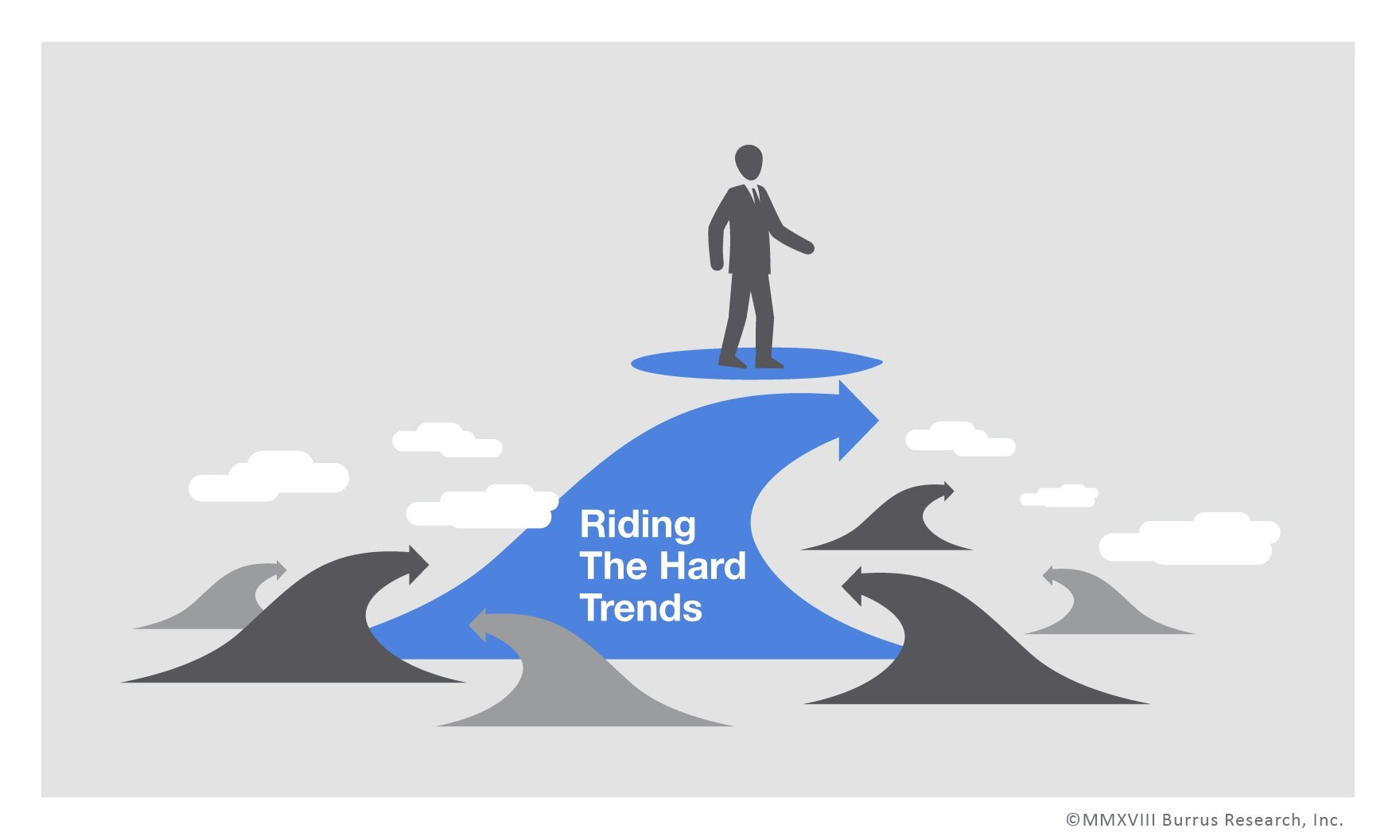TECHNOLOGY
Transforming Fear into Empowerment in an Ever-Changing World

Anticipating Change: Transforming Fear into Empowerment in an Ever-Changing World
Have you ever observed a professional colleague, a friend, or a leader whom you admire, confidently facing uncertainty without any apparent fear?
The phrase “fearless leader” must have emerged in our vocabulary for a good reason, don’t you think?
Truth be told, those individuals aren’t fearless — no one is. What they have done is mastered the feeling of fear, which has unlocked their innate ability to see disruption and change as an opportunity more quickly.
As I have noted over the years of working with many clients around the world, one common thread that ties humans together in this world of rampant disruption and change is that we all find it unpleasant in many ways. Above all else, from executives down to entry-level employees, everyone finds disruption and change frightening in some fashion.
What fear can often do to us is cloud how empowering and full of opportunity disruption and change actually is, and while I teach many individuals about utilizing Hard Trend future certainties to pre-solve problems and make low-risk moves, there are just as many stuck on the feeling of fear.

Today, I want to show you how you can utilize that same Hard Trend Methodology implemented to anticipate disruption and change prior to it occurring, but also to overcome the feeling of fear by recognizing it as a fully predictable cycle!
This really puts the power in your hands — this knowledge that everyone within your industry and outside of it will experience this same disruption and change, with you seeing it coming and forming an Anticipatory action plan around it.
The Origins of Our Fear of Disruption and Change
What is the real reason behind us as a human race fearing disruption and change? The answer lies deep within the subconscious mind. Back when human beings were still hunters and gatherers, the fight-or-flight response was necessary to basic survival. From finding food, warding off predators, and finding shelter, everything was about survival.
While humans have certainly come a long way since these primitive times, the fight-or-flight response and our roots in survival are still solidly ingrained in our subconscious mind. This explains, in simple terms, why our first thought in relation to disruption and change is fear. A change in our professional or personal status quo represents to us, now in a more contemporary way, that our daily survival tactics may be threatened.

For instance, AI disrupting your career may trigger a fear that you will lose your job to said technology, resulting in loss of income and potentially the loss of your home, transportation, and so forth.
But with disruption and change comes the ability for us to create disruption and change in an offensive strategy. Adaptation and change are inherent strengths of humans, setting us apart from digital applications and other material forces. These abilities empower us in unique ways.
Worrying that AI will replace you in the workforce is akin to the concerns of people in the past who feared the impact of desktop computers and laptops. However, as history has shown, we have successfully adapted to those digital disruptions. Today, these technologies are indispensable in both our personal and professional lives, yet we remain resilient and continue to thrive even in their presence.
A Mastery of Cycles Helps Us Adapt
The reality of fearing disruption and change is that we can fully anticipate exactly how disruption and change feels to us as individuals. In lieu of this introspection, we can more quickly go through the common stages of fear and center ourselves so well, we will eventually be able to skip our fear entirely!

This is made possible by realizing that the stages of fear are a cycle, much like a biological cycle, product cycle, and even cycles in nature, such as the future certainty that the seasons will change every year. We have all experienced fear and anxiety, and the following four stages are exactly how that feeling works through our psyche in the face of disruption and change:
-
Initial Shock
-
Frustration
-
Acceptance
-
Mastery
Let’s look at them from a more pragmatic standpoint, where we start to see that the cycle of fear itself is a Hard Trend future certainty that we can anticipate and overcome. This removes fear as a roadblock and essentially clears the way for us to focus instead on leveraging the disruption and change in front of us.
Initial Shock is the first stage. This is where the fight-or-flight response comes into play and people fear where their business or work position is headed.
Then comes Frustration, the second stage of fear. Prior to any disruption, people are comfortable in their status quo. After disruption and change occur, those disrupted must learn new skills, which can be frustrating.
The third stage in the cycle of fear is Acceptance. At this stage, people know the disruption has arrived or they have begun to leverage it to their advantage, witnessing positive results.
Mastery of the disruption or change is the final stage in the cycle. At this point, everyone has fully accepted what has changed, learned all about it, and is likely starting to use it in their daily lives.
By acknowledging and understanding that these four stages of fear occur every time we face disruption or change, we can Anticipate the feeling of fear that comes with it and move past it to find the opportunity within the disruption.
Use the Excitement of Learning to Turn Disruption into an Opportunity

We as humans have a thirst for knowledge. Similar to fight or flight, our craving to always know more is a biological response. We develop biologically all throughout our lives, and as such, we crave new information. We want to know more. We want to know everything.
Overcoming fear and learning to process that sensation more quickly allows for more room in our emotional existence to soak up all the great opportunity that comes from an ever-evolving world instead of avoiding it or trying to ignore it.
Leverage this excitement for knowledge to learn more about disruption and change so you too can help it blossom into opportunity and advantage, both personally and professionally. In turn, you become the fearless leader that others look to emulate. Train yourself to embrace disruption and change as something positive, and before long, you will be the positive disruptor of your industry!
Discover the future of AI and its transformative potential! Visit www.aiStrategyReport.com now to download the comprehensive AI Strategy Report and stay ahead in this fast-evolving landscape. Empower yourself with valuable insights and make informed decisions to unlock new opportunities. Don’t miss out on this essential resource – take action today and embrace the AI revolution!
TECHNOLOGY
Next-gen chips, Amazon Q, and speedy S3

AWS re:Invent, which has been taking place from November 27 and runs to December 1, has had its usual plethora of announcements: a total of 21 at time of print.
Perhaps not surprisingly, given the huge potential impact of generative AI – ChatGPT officially turns one year old today – a lot of focus has been on the AI side for AWS’ announcements, including a major partnership inked with NVIDIA across infrastructure, software, and services.
Yet there has been plenty more announced at the Las Vegas jamboree besides. Here, CloudTech rounds up the best of the rest:
Next-generation chips
This was the other major AI-focused announcement at re:Invent: the launch of two new chips, AWS Graviton4 and AWS Trainium2, for training and running AI and machine learning (ML) models, among other customer workloads. Graviton4 shapes up against its predecessor with 30% better compute performance, 50% more cores and 75% more memory bandwidth, while Trainium2 delivers up to four times faster training than before and will be able to be deployed in EC2 UltraClusters of up to 100,000 chips.
The EC2 UltraClusters are designed to ‘deliver the highest performance, most energy efficient AI model training infrastructure in the cloud’, as AWS puts it. With it, customers will be able to train large language models in ‘a fraction of the time’, as well as double energy efficiency.
As ever, AWS offers customers who are already utilising these tools. Databricks, Epic and SAP are among the companies cited as using the new AWS-designed chips.
Zero-ETL integrations
AWS announced new Amazon Aurora PostgreSQL, Amazon DynamoDB, and Amazon Relational Database Services (Amazon RDS) for MySQL integrations with Amazon Redshift, AWS’ cloud data warehouse. The zero-ETL integrations – eliminating the need to build ETL (extract, transform, load) data pipelines – make it easier to connect and analyse transactional data across various relational and non-relational databases in Amazon Redshift.
A simple example of how zero-ETL functions can be seen is in a hypothetical company which stores transactional data – time of transaction, items bought, where the transaction occurred – in a relational database, but use another analytics tool to analyse data in a non-relational database. To connect it all up, companies would previously have to construct ETL data pipelines which are a time and money sink.
The latest integrations “build on AWS’s zero-ETL foundation… so customers can quickly and easily connect all of their data, no matter where it lives,” the company said.
Amazon S3 Express One Zone
AWS announced the general availability of Amazon S3 Express One Zone, a new storage class purpose-built for customers’ most frequently-accessed data. Data access speed is up to 10 times faster and request costs up to 50% lower than standard S3. Companies can also opt to collocate their Amazon S3 Express One Zone data in the same availability zone as their compute resources.
Companies and partners who are using Amazon S3 Express One Zone include ChaosSearch, Cloudera, and Pinterest.
Amazon Q
A new product, and an interesting pivot, again with generative AI at its core. Amazon Q was announced as a ‘new type of generative AI-powered assistant’ which can be tailored to a customer’s business. “Customers can get fast, relevant answers to pressing questions, generate content, and take actions – all informed by a customer’s information repositories, code, and enterprise systems,” AWS added. The service also can assist companies building on AWS, as well as companies using AWS applications for business intelligence, contact centres, and supply chain management.
Customers cited as early adopters include Accenture, BMW and Wunderkind.
Want to learn more about cybersecurity and the cloud from industry leaders? Check out Cyber Security & Cloud Expo taking place in Amsterdam, California, and London. Explore other upcoming enterprise technology events and webinars powered by TechForge here.
TECHNOLOGY
HCLTech and Cisco create collaborative hybrid workplaces

Digital comms specialist Cisco and global tech firm HCLTech have teamed up to launch Meeting-Rooms-as-a-Service (MRaaS).
Available on a subscription model, this solution modernises legacy meeting rooms and enables users to join meetings from any meeting solution provider using Webex devices.
The MRaaS solution helps enterprises simplify the design, implementation and maintenance of integrated meeting rooms, enabling seamless collaboration for their globally distributed hybrid workforces.
Rakshit Ghura, senior VP and Global head of digital workplace services, HCLTech, said: “MRaaS combines our consulting and managed services expertise with Cisco’s proficiency in Webex devices to change the way employees conceptualise, organise and interact in a collaborative environment for a modern hybrid work model.
“The common vision of our partnership is to elevate the collaboration experience at work and drive productivity through modern meeting rooms.”
Alexandra Zagury, VP of partner managed and as-a-Service Sales at Cisco, said: “Our partnership with HCLTech helps our clients transform their offices through cost-effective managed services that support the ongoing evolution of workspaces.
“As we reimagine the modern office, we are making it easier to support collaboration and productivity among workers, whether they are in the office or elsewhere.”
Cisco’s Webex collaboration devices harness the power of artificial intelligence to offer intuitive, seamless collaboration experiences, enabling meeting rooms with smart features such as meeting zones, intelligent people framing, optimised attendee audio and background noise removal, among others.
Want to learn more about cybersecurity and the cloud from industry leaders? Check out Cyber Security & Cloud Expo taking place in Amsterdam, California, and London. Explore other upcoming enterprise technology events and webinars powered by TechForge here.
TECHNOLOGY
Canonical releases low-touch private cloud MicroCloud

Canonical has announced the general availability of MicroCloud, a low-touch, open source cloud solution. MicroCloud is part of Canonical’s growing cloud infrastructure portfolio.
It is purpose-built for scalable clusters and edge deployments for all types of enterprises. It is designed with simplicity, security and automation in mind, minimising the time and effort to both deploy and maintain it. Conveniently, enterprise support for MicroCloud is offered as part of Canonical’s Ubuntu Pro subscription, with several support tiers available, and priced per node.
MicroClouds are optimised for repeatable and reliable remote deployments. A single command initiates the orchestration and clustering of various components with minimal involvement by the user, resulting in a fully functional cloud within minutes. This simplified deployment process significantly reduces the barrier to entry, putting a production-grade cloud at everyone’s fingertips.
Juan Manuel Ventura, head of architectures & technologies at Spindox, said: “Cloud computing is not only about technology, it’s the beating heart of any modern industrial transformation, driving agility and innovation. Our mission is to provide our customers with the most effective ways to innovate and bring value; having a complexity-free cloud infrastructure is one important piece of that puzzle. With MicroCloud, the focus shifts away from struggling with cloud operations to solving real business challenges” says
In addition to seamless deployment, MicroCloud prioritises security and ease of maintenance. All MicroCloud components are built with strict confinement for increased security, with over-the-air transactional updates that preserve data and roll back on errors automatically. Upgrades to newer versions are handled automatically and without downtime, with the mechanisms to hold or schedule them as needed.
With this approach, MicroCloud caters to both on-premise clouds but also edge deployments at remote locations, allowing organisations to use the same infrastructure primitives and services wherever they are needed. It is suitable for business-in-branch office locations or industrial use inside a factory, as well as distributed locations where the focus is on replicability and unattended operations.
Cedric Gegout, VP of product at Canonical, said: “As data becomes more distributed, the infrastructure has to follow. Cloud computing is now distributed, spanning across data centres, far and near edge computing appliances. MicroCloud is our answer to that.
“By packaging known infrastructure primitives in a portable and unattended way, we are delivering a simpler, more prescriptive cloud experience that makes zero-ops a reality for many Industries.“
MicroCloud’s lightweight architecture makes it usable on both commodity and high-end hardware, with several ways to further reduce its footprint depending on your workload needs. In addition to the standard Ubuntu Server or Desktop, MicroClouds can be run on Ubuntu Core – a lightweight OS optimised for the edge. With Ubuntu Core, MicroClouds are a perfect solution for far-edge locations with limited computing capabilities. Users can choose to run their workloads using Kubernetes or via system containers. System containers based on LXD behave similarly to traditional VMs but consume fewer resources while providing bare-metal performance.
Coupled with Canonical’s Ubuntu Pro + Support subscription, MicroCloud users can benefit from an enterprise-grade open source cloud solution that is fully supported and with better economics. An Ubuntu Pro subscription offers security maintenance for the broadest collection of open-source software available from a single vendor today. It covers over 30k packages with a consistent security maintenance commitment, and additional features such as kernel livepatch, systems management at scale, certified compliance and hardening profiles enabling easy adoption for enterprises. With per-node pricing and no hidden fees, customers can rest assured that their environment is secure and supported without the expensive price tag typically associated with cloud solutions.
Want to learn more about cybersecurity and the cloud from industry leaders? Check out Cyber Security & Cloud Expo taking place in Amsterdam, California, and London. Explore other upcoming enterprise technology events and webinars powered by TechForge here.
-

 SEARCHENGINES6 days ago
SEARCHENGINES6 days agoGoogle Core Update Volatility, Helpful Content Update Gone, Dangerous Google Search Results & Google Ads Confusion
-

 SEO6 days ago
SEO6 days ago10 Paid Search & PPC Planning Best Practices
-

 MARKETING7 days ago
MARKETING7 days ago2 Ways to Take Back the Power in Your Business: Part 2
-

 MARKETING5 days ago
MARKETING5 days ago5 Psychological Tactics to Write Better Emails
-

 SEARCHENGINES5 days ago
SEARCHENGINES5 days agoWeekend Google Core Ranking Volatility
-

 SEO6 days ago
SEO6 days agoWordPress Releases A Performance Plugin For “Near-Instant Load Times”
-

 MARKETING6 days ago
MARKETING6 days agoThe power of program management in martech
-
SEARCHENGINES4 days ago
Daily Search Forum Recap: April 15, 2024















